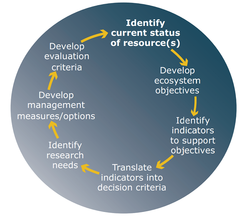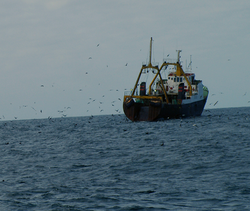Ecosystem Approach to the South African hake fishery
Background
The application of the Ecosystem Approach to Marine Resources (EAMR) is a priority for the EUROCEANS network (see Fact Sheet 2). EAMR frameworks are adaptive, incremental and geographically specific. In this Fact Sheet we report on the implementation of the EAMR to the hake fishery off South Africa. The EAMR requires a sound scientific base to provide the means of assessing the ecosystem effects of fishing as well as the success of the various management strategies adopted in response to identified risks and effects. Ecological Risk Assessment was adopted in South Africa as a means of identifying and prioritising problems associated with selected fisheries in the Benguela region. To illustrate how South Africa is moving towards the EAMR from the basis of biological research, selected ecological issues raised for the demersal fishery for Cape hakes (Merluccius capensis and M. paradoxus) are examined. The indicators required to address these issues are identified and the scientific research or monitoring studies necessary to inform these indicators are proposed. Biological or catch data are synthesised into useful indicators that enable changes and ecosystem responses to be followed in a manageable and formal way (e.g. through specific management measures). Technical management measures that may contribute to solving the issues are also suggested. This will contribute to a management strategy that optimises social and economic benefits without compromising the integrity and sustainability of the resource and its supporting ecosystem.
The hake fishery
Commercial trawling began off South Africa in 1899 and flourished with the discovery of the vast resource of Cape hakes off the West Coast. After WWII, improved technology and the discovery of Cape hake stocks off Namibia attracted a growing number of distant-water vessels to the southeast Atlantic, leading to a rapid escalation in the annual landings by the 1960s. South Africa declared a 200-nautical mile exclusive economic zone ([EEZ]) in 1977, excluded all but a small amount of foreign effort and embarked on a rebuilding strategy for the Cape hake resource through the setting of conservative annual catch limits.
The hake fishery aims to optimise the economic and social benefits of the shallow-water and deep-water Cape hake stocks without compromising the long-term biological sustainability of the hake stocks or species caught as bycatch in the hake fishery. Management of the hake fishery is via an operational management plan and aims to achieve an optimal trade-off between maximising catches and minimising the risk of resource collapse. The hake fishery is the most valuable of South African fisheries; it is estimated that the deep-sea and inshore trawl fleets account for about half the wealth generated by living marine resources in South Africa. Annual sales in 2002 amounted to approximately €195 million and the hake trawl fishery provides employment for over 8,800 people.
To address concerns over Deep-water Cape hake (M. paradoxus) depletion, an interim [total allowable catch] phase-down process was adopted in November 2005. Since 2006, the permit conditions for all fishery sectors in the hake fishery contain a specific ‘Ecosystem Impacts of Fishing’ section specifying conditions aimed at reducing the impacts of the fishery on the ecosystem, including for example specification of mitigation devices and limits on [bycatch]. Several of these conditions were previously in place, but not previously afforded sufficiently high priority.


